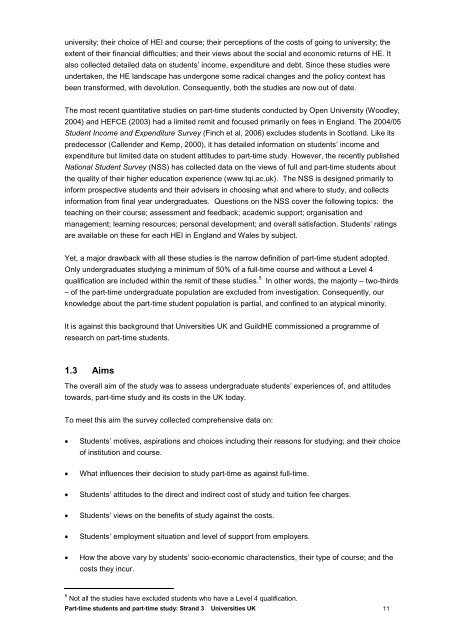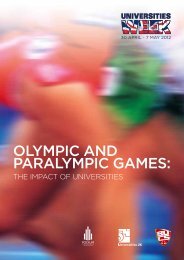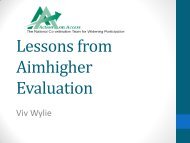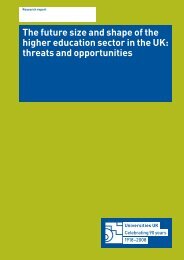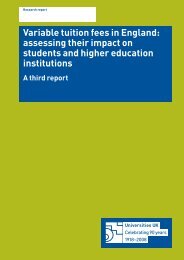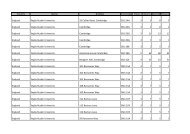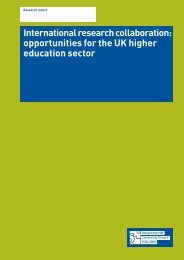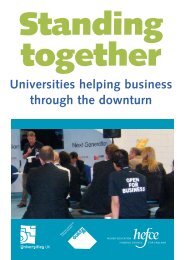Part-time Students And part-time Study In Higher ... - Universities UK
Part-time Students And part-time Study In Higher ... - Universities UK
Part-time Students And part-time Study In Higher ... - Universities UK
Create successful ePaper yourself
Turn your PDF publications into a flip-book with our unique Google optimized e-Paper software.
university; their choice of HEI and course; their perceptions of the costs of going to university; theextent of their financial difficulties; and their views about the social and economic returns of HE. Italso collected detailed data on students’ income, expenditure and debt. Since these studies wereundertaken, the HE landscape has undergone some radical changes and the policy context hasbeen transformed, with devolution. Consequently, both the studies are now out of date.The most recent quantitative studies on <strong>part</strong>-<strong>time</strong> students conducted by Open University (Woodley,2004) and HEFCE (2003) had a limited remit and focused primarily on fees in England. The 2004/05Student <strong>In</strong>come and Expenditure Survey (Finch et al, 2006) excludes students in Scotland. Like itspredecessor (Callender and Kemp, 2000), it has detailed information on students’ income andexpenditure but limited data on student attitudes to <strong>part</strong>-<strong>time</strong> study. However, the recently publishedNational Student Survey (NSS) has collected data on the views of full and <strong>part</strong>-<strong>time</strong> students aboutthe quality of their higher education experience (www.tqi.ac.uk). The NSS is designed primarily toinform prospective students and their advisers in choosing what and where to study, and collectsinformation from final year undergraduates. Questions on the NSS cover the following topics: theteaching on their course; assessment and feedback; academic support; organisation andmanagement; learning resources; personal development; and overall satisfaction. <strong>Students</strong>’ ratingsare available on these for each HEI in England and Wales by subject.Yet, a major drawback with all these studies is the narrow definition of <strong>part</strong>-<strong>time</strong> student adopted.Only undergraduates studying a minimum of 50% of a full-<strong>time</strong> course and without a Level 4qualification are included within the remit of these studies. 5 <strong>In</strong> other words, the majority – two-thirds– of the <strong>part</strong>-<strong>time</strong> undergraduate population are excluded from investigation. Consequently, ourknowledge about the <strong>part</strong>-<strong>time</strong> student population is <strong>part</strong>ial, and confined to an atypical minority.It is against this background that <strong>Universities</strong> <strong>UK</strong> and GuildHE commissioned a programme ofresearch on <strong>part</strong>-<strong>time</strong> students.1.3 AimsThe overall aim of the study was to assess undergraduate students’ experiences of, and attitudestowards, <strong>part</strong>-<strong>time</strong> study and its costs in the <strong>UK</strong> today.To meet this aim the survey collected comprehensive data on:• <strong>Students</strong>’ motives, aspirations and choices including their reasons for studying; and their choiceof institution and course.• What influences their decision to study <strong>part</strong>-<strong>time</strong> as against full-<strong>time</strong>.• <strong>Students</strong>’ attitudes to the direct and indirect cost of study and tuition fee charges.• <strong>Students</strong>’ views on the benefits of study against the costs.• <strong>Students</strong>’ employment situation and level of support from employers.• How the above vary by students’ socio-economic characteristics, their type of course; and thecosts they incur.5 Not all the studies have excluded students who have a Level 4 qualification.<strong>Part</strong>-<strong>time</strong> students and <strong>part</strong>-<strong>time</strong> study: Strand 3 <strong>Universities</strong> <strong>UK</strong> 11


